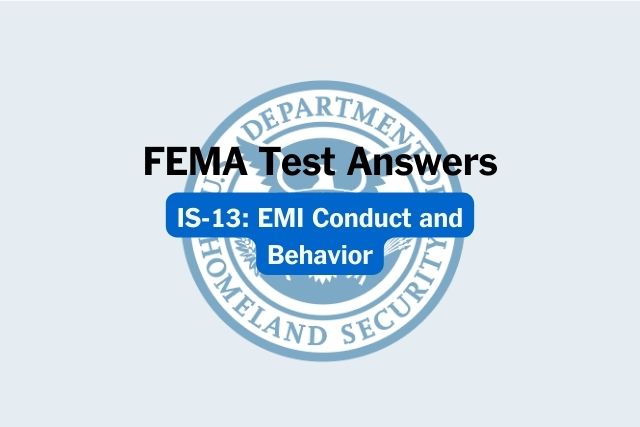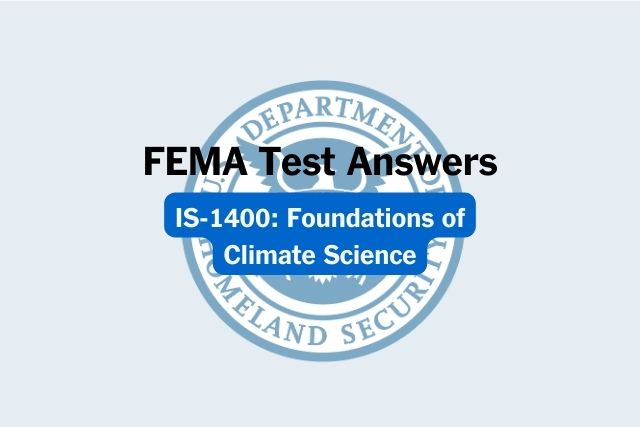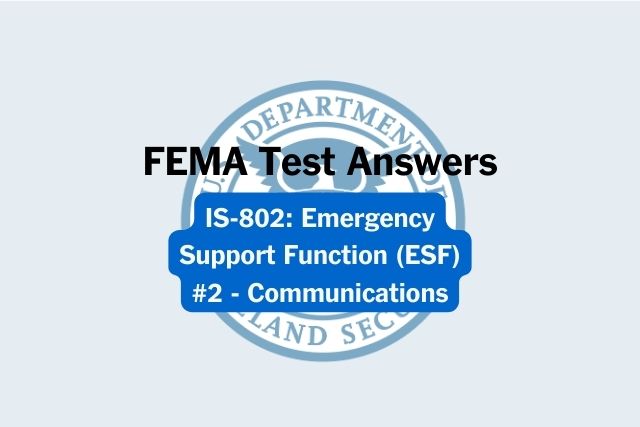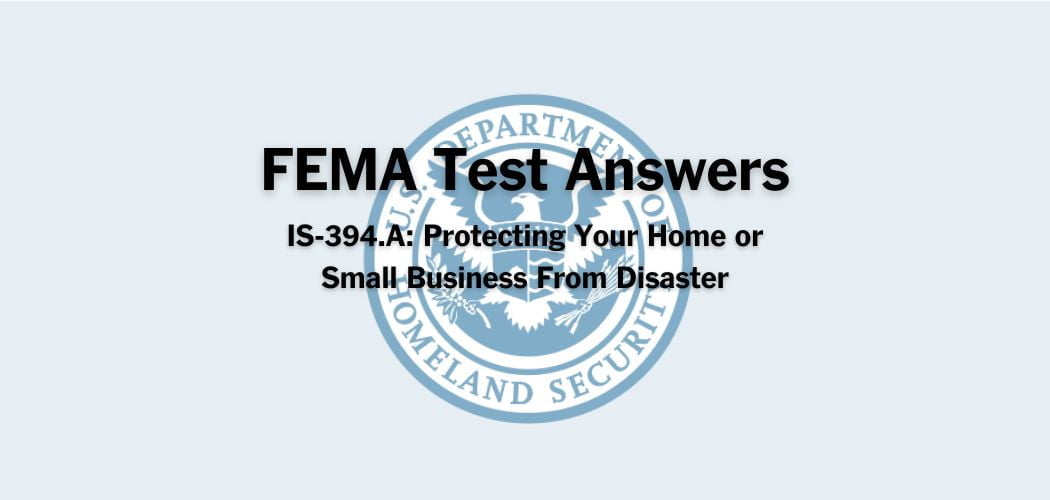Overview: The FEMA IS-289 course was published on 6/2/2021 to familiarize participants with the role of the VAL and provide a basic understanding of the VAL responsibilities and their importance in coordinating with partners across the disaster spectrum in support of survivor needs.
Primary audience: FEMA IS-289 course will also help cadres within State, Local, Tribal, and Territorial partners, non-profit organizations, and the private sector understand how to work with the VAL.
FEMA IS-289 test answers
Each time this test is loaded, you will receive a unique set of questions and answers. The test questions are scrambled to protect the integrity of the exam.
Question 1. Which of the following concepts do VALs embody in their roles to connect different individuals and organizations to collectively work together in disasters?
A. Whole Community Approach✅
B. Improved Safety Planning
C. National Planning Approach
D. Incident Command System
Question 2. VALs play a critical role in which of the four functions of ESF #6?
A. Mass Care
B. Volunteer and Donation Management✅
C. Temporary Housing
D. Human Services
Question 3. Which of the following is not a VAL responsibility when working with non-governmental organizations?
A. Secure resources to assist non-governmental communities in the phases of disaster
B. Help non-governmental organizations support their own communities
C. Tasking non-governmental organizations with specific recovery activities✅
D. Provide the support needed for non-governmental organizations to fulfill their missions
Question 4. VALs are committed to fostering the four C’s in their work. The four C’s are:
A. Community, Communication, Coordination, Continuity
B. Communication, Coordination, Cooperation, and Collaboration✅
C. Communication, Calibration, Coordination, Compensation
D. Coordination, Community, Command, Communication
Question 5. VALs work with their partner groups to ensure they are ready to serve in an emergency capacity to support operational preparedness. What is an example of operational preparedness?
A. Participating in monthly CERT training as an individual
B. The American Red Cross training volunteers from other member organizations to serve as shelter staff✅
C. Installing electrical appliances in an elevated position
D. Ensuring Memorandums of Understanding are current
Question 6. Identify the major difference between State and Federal programs.
A. Funds from State programs should be utilized first
B. States have more responsibility for program design and implementation to ensure funds from Federal programs are used to support the needs of that state’s residents✅
C. There is no significant difference
D. Federal programs are only accessible following a Federally-declared disaster
Question 7. Which of the following is not an example of effective collaboration between local leadership and NGOs?
A. Open and responsive communication
B. Know who will get the credit for doing the most work✅
C. Have a shared understanding of the value of their individual roles and partnership
D. Have a clear vision of the unmet needs and the mission
Question 8. How do VALs display respect when working with others?
A. Empowering communities to maintain their autonomy and self-determination✅
B. Serving as the leader of communities and organizations to make important decisions
C. Exercising favorability based on personal preferences to provide selective support
D. Tasking communities and organizations to serve the FEMA mission
Question 9. EMI maintains a database of standalone and Emergency Management programs with courses related to VAL roles. What is the name of this database?
A. Emergency Management College and University Program List✅
B. The College Programs
C. Emergency Management Program Database
D. The College List
Question 10. Memorandums of Understanding are statements of ______ between collaborative parties to ______.
A. Direction, host a training
B. Record, establish exchange of payment
C. Intention, determine leadership
D. Intention, achieve a common goal✅
Question 11. Which of the following non-governmental organizations can best provide emergency management and related courses to educate people in the community, as well as provide expertise in disaster response-related fields such as engineering and healthcare?
A. State government
B. Private businesses
C. Colleges and universities✅
D. Faith-based organizations
Question 12. The VAL position may look different from one locality or a government body to the next. To find out where VAL responsibilities are aligned in your area, it is best to contact:
A. FEMA Disaster Assistance Helpline
B. Your state Emergency Management Agency✅
C. FEMA Disaster Recovery Centers (DRCs)
D. Your local fire department
Question 13. Within the FEMA organization, VAL operates under:
A. Procurement Branch
B. Public Assistance Branch
C. Individual Assistance Branch✅
D. Operation Integration Branch
Question 14. VALs need to be able to _______ because they commonly serve multiple roles and have multiple responsibilities at the same time.
A. Synthesize information
B. Speak in public
C. Multi-task✅
D. Perform rescue missions
Question 15. With whom do FEMA VALs coordinate most closely at the SLTT level?
A. Representatives from national faith-based organizations
B. Only representatives from the state’s VOAD
C. Their State-level counterpart
D. Individual Assistance program office at FEMA headquarters✅
Question 16. Private sector organizations can serve as FEMA partners in disaster response, providing all the following resources except:
A. Strategic knowledge
B. Emergency management expertise
C. Donations
D. Federal Grants✅
Question 17. VALs are the central coordination point between the Federal and SLTT government and voluntary, faith-based, and community organizations. Why must VALs get to know the programs and resources of other Federal and State Agencies?
A. They may wish to seek employment with one of these organizations
B. VALs are tested on these programs and resources every year.
C. VALs provide the communities they serve information on the holistic resources offered by the Federal/State government.✅
D. It’s not necessary for VALs to be informed of the programs and resources of other Federal and State Agencies.
Question 18. VALs provide guidance to communities to support mitigation efforts and connect them with resources that can perform this type of assessment such as through the National Flood Insurance Program.
A. Repetitive Loss✅
B. Foundation
C. Security
D. Siren and Alarm
Question 19. VALs are skilled leaders who do all of the following except:
A. Create new positions at partnering organizations✅
B. Facilitate cooperation
C. Strengthen partnerships
D. Show compassion
Question 20. Which of the following is not a VAL communication activity?
A. Providing direct program support for partners and individuals during disasters✅
B. Taking complex information and articulating it in the most appropriate and concise manner to various target audiences
C. Facilitating the connection and allocation of tools and resources among communities and individuals in need.
D. Speaking to large groups of people in government agencies, partner organizations, and communities to share information about resources
Question 21. VALs main role in the Mitigation phase of a disaster situation is to provide support and connect communities and programs to resources that ______.
A. Lower the cost of flood and homeowners insurance policies
B. Provide rebates for making flood-proof updates to homes
C. Ensure the safety of levees and bridges
D. Encourage resiliency and prevent significant damage and loss of life in the next disaster.✅
Question 22. In the Recovery phase, VALs provide resources for establishing long-term recovery groups by _________.
A. Providing resources for damage assessments and emergency financial assistance
B. Providing support for household pets and service animals, distribution of supplies, and clean-up efforts
C. Providing technical assistance, training, and models for recovery structures.✅
D. Providing support for household pets and service animals, distribution of supplies, and clean-up efforts
Question 23. For organizations supporting emergency management causes, which group can facilitate connections for emergency management or disaster recovery and mitigation efforts?
A. Salvation Army
B. Lutheran Disaster Response
C. Direct Relief International
D. State VOAD✅
Question 24. VALs may present complex information using all of the following except:
A. Reports
B. Mapping
C. Verbal updates
D. Algorithms✅
Question 25. What are the major functions of ESF#6 (Mass Care) when initiated during the Response phase?
A. Sheltering, feeding, reunification, evacuee support, support for household pets and service animals, bulk distribution of supplies, clean up, damage assessments, emergency financial assistance, and housing and human services✅
B. Managing volunteers, sheltering, feeding
C. Damage assessments, clean up, setting up donations management warehouses, bulk distribution of supplies
D. Organizing donation drives, developing evacuation plans for communities, reunification
Question 26. All of the following courses offered at EMI will enhance your knowledge and skills working as or with VALs except:
A. E/G288: Local Volunteer and Donations Management
B. IS1110.A: Writing Commercial Exposures✅
C. IS288a: The Role of Voluntary Organizations in Emergency Management
D. IS244b: Developing and Managing Volunteers
Question 27. VALs promote preparedness training opportunities and preparedness grants, which can be leveraged by all of the following except:
A. State emergency management agency
B. Faith-based organizations
C. Private corporations✅
D. The VOAD Community
Question 28. Which of the following should be the initial contact or touchpoint for VALs when working with non-governmental organizations?
A. State, Territory, and Community Voluntary Organizations Active in Disaster (VOADs)✅
B. DHS Center for Faith and Opportunity Initiatives
C. FEMA Planning Specialist
D. FEMA National Advisory Council
Question 29. Which of the following is not an example of a leadership skill needed in the VAL role?
A. Initiating conversations and partnerships
B. Coaching and training others
C. Influencing partnering organizations’ financial decisions✅
D. Empowering communities and individuals
Question 30. Non-profit organizations that VALs work with can include:
A. Private businesses
B. Foreign Governments
C. Faith-based organizations✅
D. For-profit universities
Question 31. Which of the following is not a VAL leadership activity?
A. Take the initiative to self-learn
B. Task partnering organizations✅
C. Improve team performance
D. Facilitate partnerships and cooperation
Question 32. When does the Recovery phase of a disaster situation begin?
A. Fifteen days after the Response phase
B. Only when the President of the United States issues an order to begin the Recovery phase
C. As soon as clean-up efforts are initiated
D. Following or in conjunction with the immediate response phase of a disaster situation✅
Question 33. Which of the choices was not a responsibility of the FEMA Special Representatives under the Disaster Relief Act of 1974 that now translates into FEMA VAL responsibilities?
A. Provide technical assistance for donations management
B. Facilitate meetings with disaster response agencies and organizations
C. Provide response and recovery information to other voluntary organizations
D. Establish Individual Assistance and Public Assistance programs✅
Question 34. What is the primary role of the FEMA VAL staff?
A. Ensuring appropriate personnel perform and document
the facility repairs prior to the demobilization of the unit.
B. Coordinating information between FEMA, other government agencies, and Voluntary Organizations Active in Disaster (VOADs) at the local, state, and national levels✅
C. Developing contracts, Pre-Scripted Mission Assignments (PSMAs), and other mechanisms to provide resources,
programs, and services for feeding during disaster response activities
D. Coordinating with first responders and public safety during disaster response to
support organizations as necessary
Question 35. Which of the following Federal law established a cooperative agreement with the American Red Cross and assigned a Special Representative to each of the ten regions of the Federal Disaster Assistance Administration?
A. Disaster Relief Act of 1974✅
B. Federal Employees Compensation Act of 1916
C. Robert T. Stafford Disaster Relief and Emergency Assistance Act of 1988
D. Pandemic and All Hazards Preparedness Act of 2006
Question 36. Which of the following areas would a VAL not be expected to be knowledgeable in?
A. Government’s mission, values, organizational structure, programs, and resources
B. Fire safety regulations and codes✅
C. Individual Assistance (IA) and Public Assistance (PA) programs
D. Policies and regulations related to disaster support



